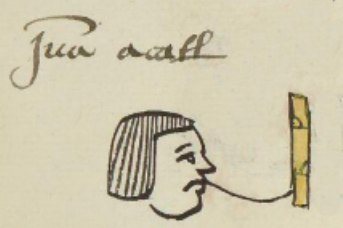Acatl (MH545r)
This black-line drawing of the simplex glyph for the personal name Acatl (“Reed,” attested here as a man’s name) shows a vertical, yellow, segmented reed or cane.
Stephanie Wood
This is a sign in the tonalpohualli, the 260-day divinatory calendar. Typically, a name with a day sign such as this would have a number with it. But by 1560, the timing of this manuscript, sometimes just the day sign was used and the number was dropping away. Alternatively, sometimes just the number was used (e.g., Macuilli), and the day sign was omitted. Whether this was happening to disguise the continued use of the tonalpohualli in naming children, which might have displeased the colonizing clergy, or whether it was a gradual, inadvertent change, is difficult to know.
Stephanie Wood
Juā acatl
Juan Acatl
Stephanie Wood
1560
Jeff Haskett-Wood
reeds, canes, carrizos, cañas, plantas

aca(tl), reed, cane, https://nahuatl.wired-humanities.org/content/acatl
Caña
Stephanie Wood
Matrícula de Huexotzinco, folio 545r, https://www.loc.gov/resource/gdcwdl.wdl_15282/?sp=169&st=image
This manuscript is hosted by the Library of Congress and the World Digital Library; used here with the Creative Commons, “Attribution-NonCommercial-ShareAlike 3.0 License” (CC-BY-NC-SAq 3.0).




